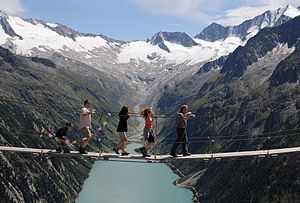Simple suspension bridge

A simple suspension footbridge in the Zillertal Alps
|
|
| Ancestor | None |
|---|---|
| Related | None |
| Descendant | Underspanned suspension bridge, Suspended-deck suspension bridge, Stressed ribbon bridge |
| Carries | Pedestrians, |
| Span range | short to medium |
| Material | Rope (fiber), chain, steel wire rope; appropriate decking material |
| Movable | No |
| Design effort | low |
| Falsework required | No |
A simple suspension bridge (also rope bridge, swing bridge (in New Zealand), suspended bridge, hanging bridge and catenary bridge) is a primitive type of bridge that is supported entirely from anchors at either end and has no towers or piers. However, it may have saddles. In such bridges, the deck of the bridge follows the downward and upward arc of the load-bearing cables, with additional light ropes at a higher level used to form a handrail. Alternatively, stout handrail cables supported on short piers at each end may be the primary load-bearing element, with the deck suspended below. Suspended well from two high locations over a river or canyon, simple suspension bridges follow a shallow downward catenary arc and are not suited for modern roads and railroads. Owing to practical limitation in the grade (i.e. the deck being an arc, not flat) and the response to dynamic loads of the bridge deck, this type is quite restricted in its load-carrying capacity relative to its span. This type of bridge is considered the most efficient and sustainable design in developing countries, however, especially for river crossings that lie in non-floodplain topography such as gorges.
In some contexts the term "simple suspension bridge" refers not to this type of bridge but rather to a suspended deck bridge that is "simple" in that its deck is not stiffened. Although simple suspension bridges and "simple" suspended deck bridges are similar in many respects, they differ in their physics. On a simple suspension bridge, the main cables (or chains) follow a hyperbolic curve, the catenary. This is because the main cables are free hanging. In contrast, on a suspended deck bridge (whether "simple" or not) the main cables follow a parabolic curve. This is because the main cables are tied at uniform intervals to the bridge deck below (see suspension bridge curve). The differences between these two curves was a question of importance in the 17th century, worked on by Isaac Newton among others.
A stressed ribbon bridge also has one or more catenary curves and a deck laid on the main cables. Unlike a simple suspension bridge however, a stressed ribbon bridge has a stiff deck, usually due to the addition of compression elements (concrete slabs) laid over the main cables. This stiffness allows the bridge to be much heavier, wider, and more stable.
...
Wikipedia
